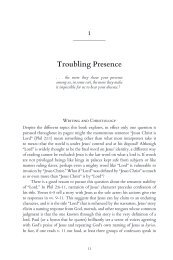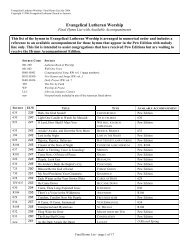19. Pastoral Letters: 1 Timothy, 2 Timothy, Titus - Augsburg Fortress
19. Pastoral Letters: 1 Timothy, 2 Timothy, Titus - Augsburg Fortress
19. Pastoral Letters: 1 Timothy, 2 Timothy, Titus - Augsburg Fortress
Create successful ePaper yourself
Turn your PDF publications into a flip-book with our unique Google optimized e-Paper software.
Copyrighted Material<br />
1 <strong>Augsburg</strong> timothy, <strong>Fortress</strong> 2 timothy, Publishers titus 441<br />
These elements are dominated, however, by the practical instructions and the context<br />
of moral exhortation, with its “sound teaching” (1:10; 6:3), “training in godliness”<br />
(1:4; 4:7), and “good conscience” (1:5, 19; 3:9).<br />
The Household of God<br />
First <strong>Timothy</strong> does not provide a full and satisfying picture of the community structure<br />
of the Ephesian church. The instructions deal with matters of immediate pertinence<br />
to the author and his delegate, rather than to the historian’s curiosity.<br />
The author calls the church the household of God (oikos tou theou; 3:15). In other<br />
letters, Paul uses the expression “the church in the household of . . .” (cf. Rom. 16:5; 1<br />
Cor. 16:19; Col. 4:15), although he can also speak metaphorically of community<br />
members as “household servants” (Rom. 14:4) or “members of a household” (Gal.<br />
6:10; Eph. 2:19). It is important to note here that the church as intentional community<br />
is not completely assimilated to the household structure. A distinction is made several<br />
times between “one’s own household” and the community (1 Tim. 3:4-5, 12; 5:4). In<br />
fact, the most important function of the household in this letter is to provide an analogy<br />
for leadership: administrative abilities and leadership skills demonstrated in one<br />
structure carry implications for another. There is also a distinction—however unclear<br />
to present-day readers—drawn between the life and responsibilities of individual<br />
households and the life and responsibility of the church (see 5:4, 8, 16). The church<br />
imitates the household in many respects, but is not subsumed by it. Since early Christians<br />
met in houses—within the sphere of the household—such associations were<br />
inevitable.<br />
Paul’s directions to <strong>Timothy</strong> apply to several different spheres of the community’s<br />
life. Some are directed to the life of individual households and the community members<br />
living within them. Such are the remarks about slaves belonging to Christian<br />
masters (6:1-2) and those about rich members of the community who are not to rely<br />
on their wealth but use it for helping others (6:17-19). Similar is the demand that individual<br />
children within households provide for widows (5:4, 8, 16) and the banal yet<br />
pertinent advice on the attitudes that <strong>Timothy</strong> should display toward diverse age and<br />
gender groups (5:1-2). There is little dramatic in this advice and nothing implausible.<br />
The author wants order, propriety, and graciousness in the domestic lives of believers.<br />
Some—not much—attention is paid to the liturgical life of the community, but<br />
with a focus different from the instructions concerning the Lord’s Supper and charismatic<br />
gifts in 1 Corinthians 11–14. Three very specific directives are given. First,<br />
prayers are to be said for all people, especially rulers (2:1-4). This is certainly unexceptional,<br />
as is the second instruction, which is that the male members, who pray with<br />
uplifted arms, should not have anger or quarreling among them (2:8).<br />
The instructions about women are somewhat more problematic. The contrast<br />
between luxurious external adornment and the life of internal virtue (2:9-10) is




